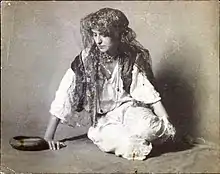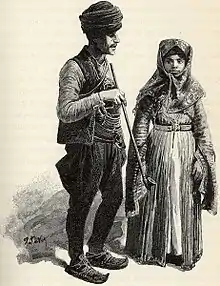Muslim Roma
Muslim Roma are Romani people who adopted Sunni Islam of Hanafi madhab, and Turkish culture, some of them are Derviş of Sufism, and founded their own Muslim Roma Tariqa. They are Cultural Muslims. The Muslim Roma Men are all Circumcised. Roma have usually adopted the predominant religion of the host country. Islam among Roma is historically associated with life of Roma within the Ottoman Empire. Correspondingly, significant cultural minorities of Muslim Roma are found in Turkey (majority live in East Thrace), Bosnia and Herzegovina, Albania, Montenegro, Kosovo, Republic of North Macedonia, Bulgaria, (by mid-1990s estimates, Muslim Roma in Northern Thrace constituted about 40% of Roma in Bulgaria.[1]), (a very small group of Muslim Roma exists in the Dobruja region of Romania, comprising 1% of the country's Romani population[2]), Croatia (45% of the country's Romani population[3]), Southern Russia, Greece (a small part of Muslim Roma concentrated in Western Thrace), Serbia and Crimea. Some speak the Balkan Romani, but the majority speak only the Language from the Host countrys.


Because of the relative ease of migration in modern times, Muslim Roma may be found in other parts of the world as well. The Muslim Roma also used the word Gypsy for themself, because they didnt see it as a slurword. The Muslim Roma' culture is based of the Culture of the Ottoman Empire.
After the collapse of the Ottoman Empire in the parts where Islam is no longer a dominant religion Muslim Roma have found themselves under double discrimination, both due to Antiziganism and Islamophobia.[4]
Muslim Roma throughout Southern Europe are called by Non Romani and Christian Romani People as Horahane Roma (also spelled as Khorakhane, Xoraxane, Kharokane, Xoraxai, etc.) and are colloquially referred to as Turkish Roma or Turkish Gypsies in the host countries. They believe to be descandants of Vaishyas (Merchants) from different places at the Coastal India, who came trough the Indo-Roman relations to Egypt (Roman province), and Believer of the Indo-Greek religions and there Doctrin was the Romaka Siddhanta. With the time they became Roman citizenship and named after the Roman empire. From 1531 until 1913, the Turkish speaking Muslim Roma got their own Sanjak in the Ottoman Empire, the so called Çingene Sanjak in Thrace, and ruled by a local Muslim Rom Baro the so called Çingene Bey. Under the Ottoman Rule, the Christian and Muslim Roma were separated. Muslim Roma were forbidden to marry Christian Roma. There are great differences, between Muslim and Christian Roma, emerged through the centuries. Muslim Roma have the Oriental Lifestyle based on the Islamic culture. After the World War II, large numbers of Muslim Roma from the Balkans wanted to settle in Halaib Triangle and asked to rebuild the city of ʿAydhab.
References
- Gerd Nonneman, Tim Niblock, Bogdan Szajkowski (Eds.) (1996) "Muslim Communities in the New Europe", ISBN 0-86372-192-3
- Ana Oprişan, George Grigore, "The Muslim Gypsies in Romania" Archived 2009-03-05 at the Wayback Machine, in International Institute for the Study of Islam in the Modern World (ISIM) Newsletter 8, September 2001, p.32; retrieved June 2, 2007
- "Archived copy" (PDF). Archived from the original (PDF) on 2007-07-27. Retrieved 2009-02-06.CS1 maint: archived copy as title (link)
- Peter G. Danchin, Elizabeth A. Cole (Eds.) (2002) "Protecting the Human Rights of Religious Minorities in Eastern Europe", ISBN 0-231-12475-9
Further reading
- Roma Muslims in the Balkans by Elena Marushiakova and Vesselin Popov
- Dialect of Xoraxané Roma (in Italian)
- Romá by Leonardo Piasere